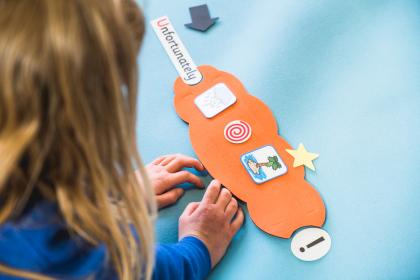Exciting Activities for Sentence Making in Key Stage One
Sentence making is a fundamental aspect of literacy development for Key Stage One students. It plays a crucial role in helping young learners understand the structure and meaning of sentences, which forms the foundation for effective communication and writing skills. By engaging pupils in sentence making activities, teachers can create a stimulating learning environment that enhances their literacy abilities.
In this blog post, we will explore the importance of sentence making, share fun and interactive activities to improve sentence structures, and highlight how Mighty Writer can be used as a tool to enhance sentence making in the classroom.
Let's dive in and discover how sentence making activities can transform the way Key Stage One pupils learn to write!
The Importance of Sentence Making
Sentence making is a crucial skill for young learners as it forms the building blocks of effective communication. When children understand how to construct sentences, they can express their thoughts and ideas more clearly and coherently. It also helps them develop a deeper understanding of language structure and grammar.
Sentence making activities provide an opportunity for pupils to practice using different sentence structures, such as simple, compound, and complex sentences. This not only improves their writing skills but also enhances their reading comprehension. When pupils can analyse and deconstruct sentences, they become more proficient in understanding the meaning and context of texts.
Fun and Interactive Sentence-Making Activities
Engaging Key Stage One pupils in sentence-making activities can make the learning process more enjoyable and effective. By incorporating creativity and interactive elements, teachers can capture their pupils' attention and foster a love for writing. Here are some fun and interactive activities to improve sentence structures:
Story Starters: Provide pupils with a sentence or a few words to kickstart their story. Encourage them to continue the story by building sentences around the given prompt. This activity not only helps pupils practice sentence construction but also sparks their imagination and storytelling skills.
Sentence Building Games: Turn sentence-making into a game by using flashcards or sentence building blocks. Children can work individually or in groups to arrange the cards or blocks to form complete sentences. This activity allows them to experiment with different sentence structures and helps them understand the importance of word order and punctuation.
Sentence Scramble: Create a set of sentence strips with the words in the wrong order. Pupils must rearrange the words to form correct sentences. This activity challenges their critical thinking and problem-solving skills while reinforcing the concept of sentence structure.
Collaborative Sentence Writing: Divide the class into small groups and provide each group with a large sheet of paper. Each child takes turns adding a word or a phrase to build a sentence collaboratively. This activity encourages teamwork and helps pupils understand how individual words contribute to the overall meaning of a sentence.
Using Mighty Writer to Enhance Sentence Structures
Mighty Writer is a powerful tool that can greatly enhance sentence making in the classroom. It offers a tactile and interactive approach to learning, which engages Key Stage One children and makes the process more enjoyable.
With the Mighty Writer Resource, pupils can physically manipulate sentence clouds and velcro symbols to construct sentences. This hands-on experience helps them understand the different components of a sentence, such as adjectives, verbs, and objects. By arranging the symbols on the Mighty Writer mat, children can visualise the structure of a sentence and experiment with different word orders to create meaningful and grammatically correct sentences.

The varying toolbars provided by Mighty Writer offer an extension to the resource, featuring more picture tiles to tell more stories. This allows children to expand their vocabulary and explore various sentence structures. They can create descriptive sentences, compound sentences, or even complex sentences by incorporating different symbols and tiles.
Teachers can utilise the Teacher's Guide for implementing Mighty Writer in the classroom. The guide provides a lesson plan, the story behind Mighty Writer, and a review of its effectiveness. It serves as a valuable resource for teachers to effectively incorporate Mighty Writer into their lesson plans and ensure maximum impact on their pupils' sentence-making skills.
Furthermore, Mighty Writer offers CPD training in the form of workshops and training sessions for teachers and staff. These sessions provide in-depth knowledge of how to best utilise Mighty Writer in the classroom, strategies for engaging children in sentence-making activities, and tips for effective implementation.
Mighty Writer also offers special packages and discounts for multi-academy trusts, making it an affordable and accessible resource for schools. This ensures that more schools can benefit from Mighty Writer's transformative impact on sentence-making.
With ongoing and unlimited CPD training, teachers and staff can continuously improve their skills and knowledge in sentence-making instruction. This ensures that they are equipped with the latest strategies and techniques to engage pupils and enhance their sentence-making abilities.
Mighty Writer is not just a tool; it is a comprehensive solution for enhancing sentence structures and literacy skills in Key Stage One pupils. By incorporating Mighty Writer into the classroom, teachers can create a stimulating and engaging learning environment that transforms the way children learn to write.
Tips for Engaging Key Stage One Pupils in Literacy with Sentence-Making Activities
Engaging Key Stage One pupils in sentence-making activities can be a rewarding experience for both teachers and pupils. Here are some practical tips to keep in mind:
1. Make it relevant: Connect sentence-making activities to real-life situations or topics that interest your pupils. This will make the learning experience more meaningful and engaging.
2. Use visuals: Incorporate visual aids, such as images or diagrams, to support sentence construction. This can help pupils visualise the concepts and make connections between words and their meanings.
3. Provide scaffolding: Start with simple sentence structures and gradually increase the complexity as children become more confident. Provide sentence frames or word banks to support pupils who may need extra guidance.
4. Encourage collaboration: Foster a collaborative learning environment where children can work together to construct sentences. This promotes peer interaction, discussion, and the sharing of ideas.
5. Celebrate creativity: Encourage pupils to be creative with their sentence-making. Allow them to experiment with different word choices, sentence lengths, and sentence types. Celebrate their unique ideas and expressions.
6. Provide feedback: Offer constructive feedback on pupils' sentence-making efforts. Highlight areas of improvement and provide specific suggestions for sentence structure enhancement.
7. Make it fun: Incorporate games, challenges, and rewards into sentence-making activities. This will add an element of fun and motivation, making the learning experience more enjoyable for children.
By implementing these tips, you can create a positive and engaging learning environment that fosters a love for sentence-making in Key Stage One pupils. Remember, the goal is to make the process enjoyable while effectively enhancing their sentence construction skills.
Conclusion
Engaging Key Stage One children in sentence-making activities is an essential aspect of their literacy development. By incorporating fun and interactive exercises, teachers can make writing exciting and improve sentence structures. Mighty Writer plays a vital role in enhancing sentence making skills in the classroom, allowing pupils to manipulate sentence clouds and symbols to construct meaningful sentences.
Through the use of the Mighty Writer resource and its varying toolbars, pupils can expand their vocabulary and explore different sentence structures. Teachers can implement Mighty Writer with the help of the Teacher's Guide, which provides valuable resources and lesson plans for effective implementation.
By utilising Mighty Writer, teachers can create a stimulating and engaging learning environment that transforms the way Key Stage One pupils learn to write. With ongoing CPD training and special packages for multi-academy trusts, Mighty Writer offers comprehensive support for teachers and schools.
So, let's embrace the power of sentence-making activities and Mighty Writer to boost literacy results and foster a love for writing among Key Stage One children!
